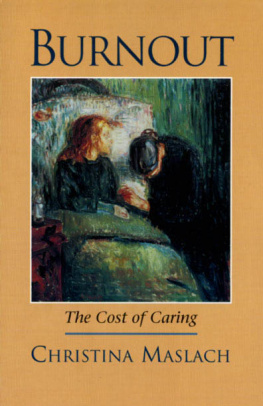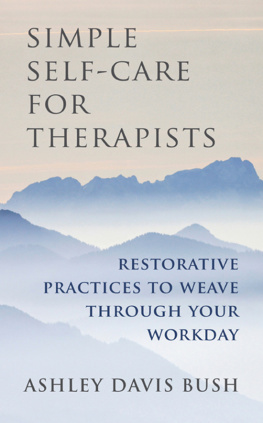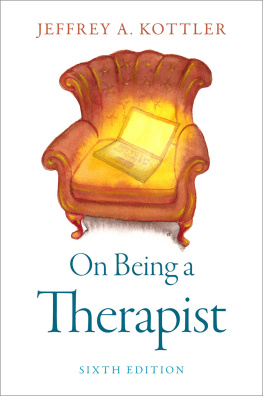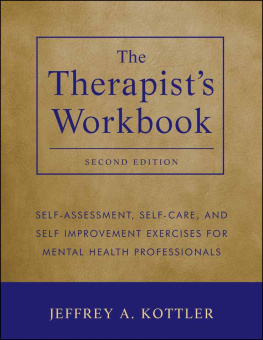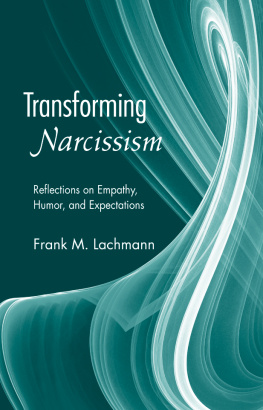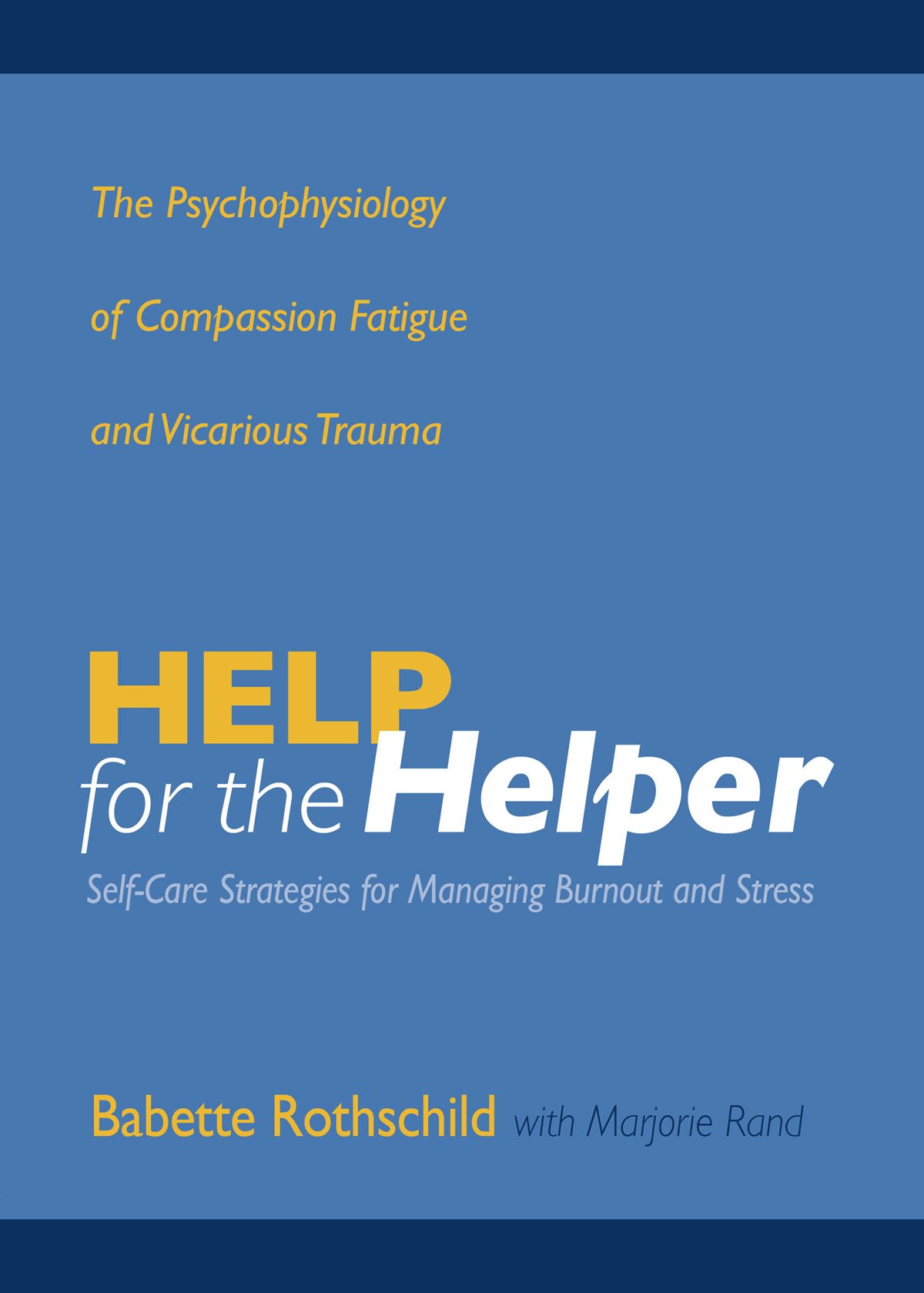Contents
Guide
Page List
HELP
for the Helper
The Psychophysiology of Compassion Fatigue and Vicarious Trauma
BABETTE ROTHSCHILD
with
MARJORIE L. RAND

A Norton Professional Book
This e-book contains some places that ask the reader to fill in questions or comments. Please keep pen and paper handy as you read this e-book so that you can complete the exercises within.
This book is dedicated to all of the helpers
Contents
I n the introduction to The Body Remembers Casebook (2003a), I discussed the importance of applying common sense to work with trauma. Generally, I find both the skill and trend sorely missing in the practice of psychotherapy, so I speak about common sense regularly in lectures and training programs. It continues to amaze me that many, many people approach me during breaks to say how important or refreshing it is to finally hear someone talk about using common sense. When I take an informal poll of how many in my audience were taught or encouraged to use their own innate common sense during their education or professional training, somewhere between 10% and 33% raise their hands. I have never seen as much as half the audience with their hands up. Though I am proud to contribute to filling this neglected gap, I am appalled that it is necessary. Every training program in psychotherapy (university, organization, agency, or institution alike) should be teaching, promoting, and supporting the use of common sense alongside the other theory and tools that are being taught. The success of both the psychotherapy of clients and the self-care of psychotherapists is greatly enhanced by the liberal application of common sense. With regard to the topic of this book, Help for the Helper, applying common sense could save heaps of professional pain and suffering. Moreover, it could also probably save agencies and HMOs plenty of actual dollars.
Temple Grandin (2005), author of Thinking in Pictures and Animals in Translation, is the well-known animal behaviorist who also is afflicted with high-functioning autisim. Her brilliance in designing handling systems for livestock (which she has done over much of the United States and Canada) is not only rooted in her talent for visualization, but is also largely the product of common sense. Her cornerstone is a simple assumption: If animals are scared, then something is scaring them. For her it is that simple. As a result, she counsels that no matter how much you use an electric prod, the animals will still be afraid to cooperate and will balk at what you want them to do. The more you prod, the more afraid they will be. Grandin demonstrates time and again that simply identifying and changing or removing the source of their fearthe trigger, as we would say(often something as simple as covering a reflective piece of metal) removes the need for electric prods. The animals just become calmly cooperative.
The same principle applies to us. If we are suffering under the weight of our work or from interactions with particular clients, then identifying and changing the triggering circumstances should give us much-needed relief. Of course, sometimes making these changes is easier said than done. But the principle is the same: Use your common sense to identify your work stressors and develop strategies to intervene. Here is one example.
During a recent consultation, a fairly experienced therapist complained of severe stress due to feelings of failure and guilt. He had been struggling with one of his clients and felt unable to help. Probing, I discovered that he actually did not have the knowledge base necessary to work with that type of client. From the perspective of common sense, I saw two basic options: (1) refer the client to someone who does have the skills and knowledge that are needed, or (2) hire a supervisor or consultant who could coach him through or teach him what is needed along the way. Either choice would go a long way to assuaging both guilt and failure feelings, and the client would actually be helped. I further advised that the therapist make peace with reality: No single therapist canor shouldtreat all clients. That is also common sense.
Amid the theory and exercises in this book, you will also find (what I hope are) generous helpings of common sense. I expectand welcomethat some readers will finish this book and say, Yes, how simple! in reaction to portions of the theory and skills presented. Much of it really is simple. Becoming adept at self-care does not require long training programs (though I do love to give workshops on these topics). Mostly, you just need to use your common sense.
HELP
for the Helper
The Psychophysiology of Compassion Fatigue and Vicarious Trauma
Toward the end of the Haunted Mansion ride at Disneyland, the black coach Im riding in turns to face a mirror. I can clearly see the reflections of myself and the friends Im riding with. There is also the faded reflection of one or more ghosts who appear to be riding along with us in our laps. They are smiling and carrying suitcases, intent on hitching a ride home with us. Of course, at the end of the ride, there are not really any ghosts hanging on to us nor are they in the car when we get home.
W ith our clients, however, that is not always the case. Sometimes it seems that some of them are more successful than the Haunted Mansion ghosts: In essence, they hitch a ride home with usor, more accurately, inside of us. Often we are not aware that we have brought home an unwelcome visitor unless we notice that we are agitated rather than relaxed, have trouble sleeping, or pick a useless fight with our partner and make the connection.
When this happens once in a great while, the consequences are usually minimal. But for practitioners who consistently bring their clients homeconsciously or unconsciouslythe impact over time can be severe. This books mission is to prevent just that, and to promote the stance that we need not bring our clients home with us to qualify as compassionate or competent practitioners. In fact, the opposite may actually be the case: The better we take care of ourselves and maintain a professional separation from our clients, the more we will be in a position to be truly empathetic, compassionate, and useful to them.
It is my hope that this book will radically change the ways in which psychotherapists conceptualize, as well as act on, the risks of their profession, including compassion fatigue and vicarious traumatization. Additionally, I hope to influence current thinking about ways in which therapists are affected by their clients. Along the way, I will discuss the science of these phenomena and offer practical strategies that will aid the therapist in taking charge of these potential hazards rather than feeling at their mercy.
Of course, psychotherapists are not the only helping professionals who are affected by these and other phenomena discussed in this volume. However, since therapists comprise the vast majority of potential readers, vocabulary and examples are aimed at them. However, as with my first book, The Body Remembers: The Psychophysiology of Trauma and Trauma Treatment (Rothschild, 2000), I expect that a good number of readers will be members of the other helping professions (doctors, nurses, emergency workers, massage and other body therapists, administrators, etc.) and others will be laypersons. Please feel free to translate the examples and exercises into your own language and realm of professional or personal experience. You are welcome to try out and share any of the exercises in this book with your own supervisees, colleagues, and students. In addition, if you have any questions or if you have particularly positive or negative results from using the skill-building sections, please let me know (my contact information is on the copyright page following the title pagee-mail is easiest).


